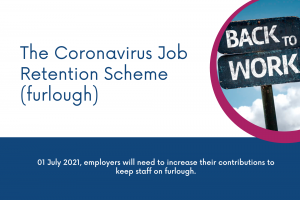Many of you will already be using the government scheme, designed to save jobs and provide some much-needed financial help to a business by a grant reimbursing 80% of an employee’s wages (subject to a cap of £2500). You can read more about the scheme in our previous guide.
Increased employer contributions from 1 July 2021
Much like what we saw this time last year, from 01 July 2021, employers will need to increase their contributions to keep staff on furlough.
Thus far, furloughed employees have continued to receive 80% of their salary subject to the £2500 cap but employers will need to pay part of the furlough salaries over the coming months:
July – The Government will continue to pay 70% of furloughed employees’ salaries up to a cap of £2,187.50 per month. Employers will also pay national insurance and pension contributions, and 10% of wages to make up 80% of the total, up to a cap of £2,500 per month. Employers will also pay for any part-time hours worked.
August & September – The Government will continue to pay 60% of furloughed employees’ salaries up to a cap of £1,875 per month. Employers will also pay national insurance and pension contributions, and 20% of wages to make up 80% of the total, up to a cap of £2,500 per month. Employers will also pay for any part-time hours worked.
Workforce Planning
Think about your business now and plan ahead. Which category do you fall into?
- Are you operating as normal or indeed busier than normal?– you should think about recruitment, improving longer-term home working, making your workplace safe in line with Govt guidance
- Are you hoping to return to something less than normal over the next few months?– consider taking staff off furlough with some staff rotation, get health and safety right, take advice on the variation of terms and conditions with less pay and hours if appropriate and plan redundancies
- Are you expecting a big reduction in operations?– extend furlough to 31 September and plan redundancies and restructures with appropriate advice
- Are you anticipating that your business won’t survive?– take business turnaround and as a last resort insolvency advice.
Working from home or returning to the workplace?
If people can continue to work from home, you may want to consider this as a more permanent measure for your workplace, or at least look to offer reduced number in the office, on a flexible rotation system. Many of the calls we are receiving from our clients lead me to believe that most businesses want staff to return to the workplace.
Can I force staff to return to work?
There will be some employees who will refuse to return, some who prefer to be on furlough as long as possible and some who have genuine concerns for their safety. In law, an employee is protected from detriment and dismissal if they refuse to attend a workplace where they are in “serious and imminent danger”. The employee’s belief must be genuine and reasonable. So, your job over the next few weeks is to ensure that you can provide a safe place to work.
How do I make my premises safe?
The government guidance is set out here and more is to follow. You should read the guidance for your sector and if you need help our Health and safety service is a good support for you. The starting point is 5 steps to follow to demonstrate to staff and visitors that you are operating a safe workplace. You can read more about the 5 steps in our previous guide. Here is a handy checklist to help you conduct some workforce planning
Legal considerations
There will also be a number of employment law and HR issues that need to be Covered:
- You should seek written agreement with staff to be furloughed and unfurloughed
- Make sure that your payroll staff or provider are aware that furlough has ended or been adjusted for these staff and they should return to full pay for time worked (taking into account the national minimum and living wage rates increases from April for any staff employed on those rates).
- From 1 July to 31 September the employer and employee can agree working arrangements whereby the employee resumes work part-time whilst the Government will continue to fund a proportion of furlough pay for the non-working time.
Redundancies
We are currently having to advise a number of clients about various options, including redundancy. It is essential that you take expert advice before embarking on a redundancy exercise to avoid facing expensive tribunal claims for unfair dismissal.
See our redundancy guide here.[/vc_column_text][vc_column_text]
How can we help?
If you need support and specialist advice you can speak to us in confidence on 0114 3032300 or email hello@bhayanilaw.co.uk.
If you are a Watertight client our advice and the necessary letters to give to staff are included in your package. If you want to know more about becoming a Watertight member you can look here.








